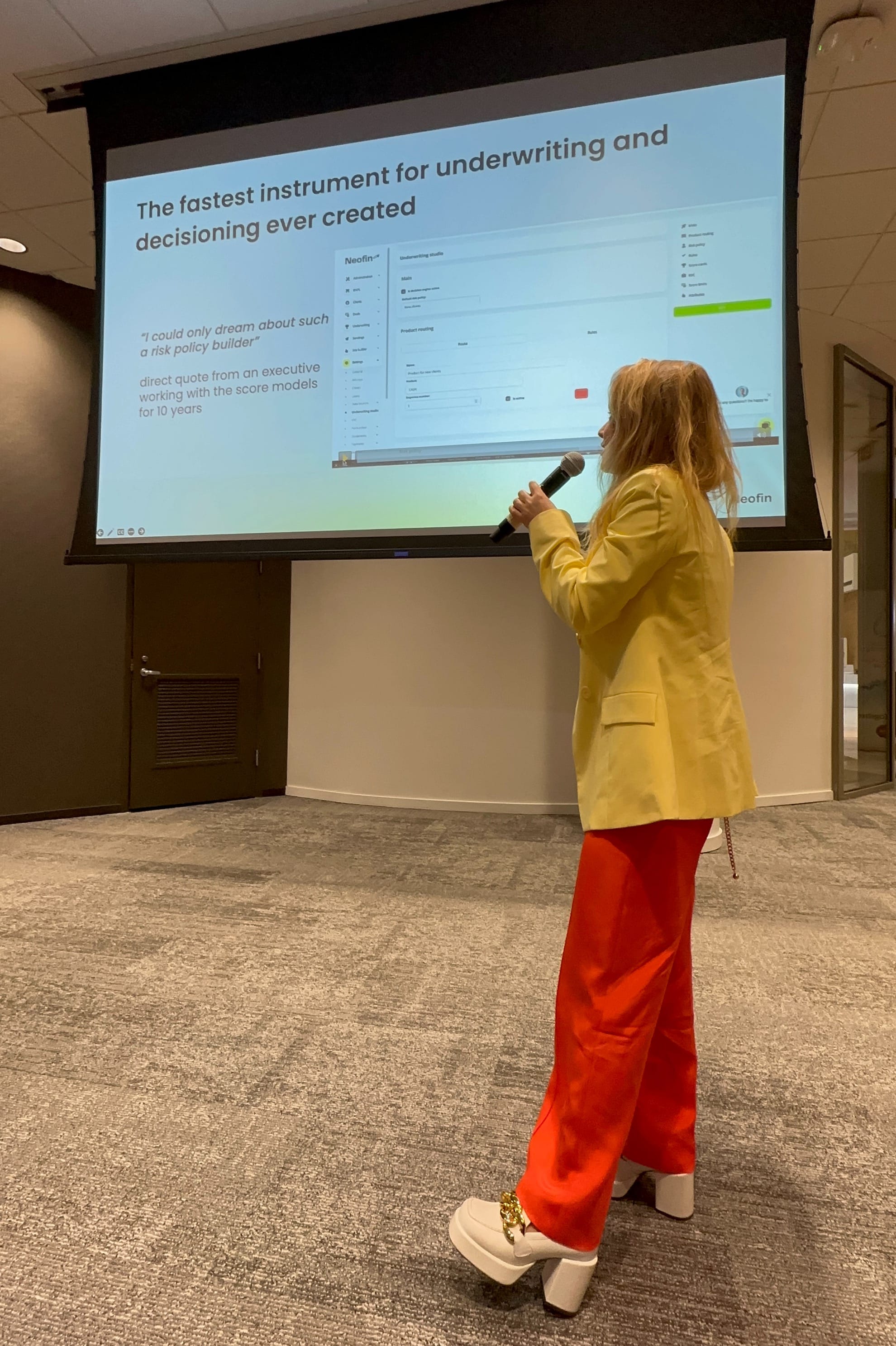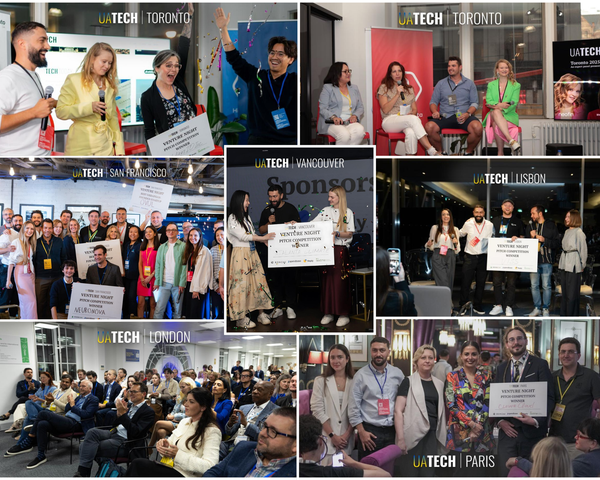AI in FinTech: More Than Just a Buzzword
If you’ve been in FinTech long enough, you know that AI is one of those buzzwords that gets thrown around a lot. Everyone talks about it, but which fintech challenges does AI cover in a way that delivers real results? That’s the question I’ve been asking myself as a founder, as a diligent user of AI tools, and as a builder of an ecosystem within financial technology.

Now as I am wrapping up the bustling Fintech Meetup, AI is all over my notes on insights - again. Thus, in this FinTech Editor’s Pick, I’m sharing five AI-powered innovations already transforming financial technology, backed by real-world examples and my own experience as a co-founder at Neofin.
We’ll go over:
💡 Processes AI is already covering, from customer service to risk assessment, fraud detection, lending automation, and compliance.
💡 Who’s getting results: we’ll look at how the biggest players like Klarna, JPMorgan, and others are using AI successfully and what outcomes they’re seeing.
💡 How to leverage AI (even if you're not a giant yet): workarounds and scalable AI strategies that smaller FinTechs can adopt right now to stay competitive.
If 2023 was the year of the AI breakthrough and 2024 was the year of experimentation, then 2025 is the year of real, ROI-driven execution. Companies are no longer just testing AI — they’re demanding tangible outcomes.
So let’s cut through the noise and focus on what works. Diving in!
1️⃣ AI-Powered Customer Support in Fintech: Klarna's Move to AI-Driven Service
Use Case: Replacing human support agents with AI-powered automation.
We’ve all had frustrating customer service experiences: long wait times, unhelpful responses, and endless transfers. FinTechs aren’t immune, and handling high volumes of customer inquiries has always been a challenge. That’s why Klarna made headlines when it… replaced 700 support agents with AI-driven automation!
Today, Klarna’s AI handles two-thirds of all customer inquiries faster, more efficiently, and at a fraction of the cost. Klarna's AI assistant launched globally in early 2024, has significantly transformed the company's customer service operations.
Quick numbers will tell it all:
- 2.3 million conversations handled in month 1. This implementation is equivalent to the work of 700 full-time agents.
- The AI assistant has matched human agents in customer satisfaction scores and improved issue resolution accuracy, leading to a 25% decrease in repeat inquiries.
- Average resolution times were reduced from 11 minutes to under 2 minutes.
- 23 markets of operation
- 35 languages supported
- Approximately $40mln contribution to Klarna’s profits in 2024 according to Illuminateai.co.uk
🔹 Why this matters: Klarna’s move shows that AI isn’t just a support tool. It’s becoming a primary driver of customer service in FinTech. For startups and scale-ups, this raises an important question: How much of your customer support can AI realistically handle, and what’s the right balance between automation and human touch?
2️⃣ AI in Document Processing: From OCR to LLM
Use Case: Automating complex document-heavy loan applications.
At Neofin, we operate in the lending space. And this is one of the most document-heavy areas of FinTech. Whether it’s small business loans, credit line applications, or credit approvals, the amount of paperwork can feel overwhelming. And until recently, most FinTechs (including us at Neofin) relied on OCR (Optical Character Recognition) to extract data from these documents. That did help with automation, but the process has always been nuanced and had its limitations, particularly dealing with:
- Non-standard document templates
- Handwritten or scanned documents
- Multiple languages
- Complex financial statements

So last year, we made a major shift: we replaced OCR with Large Language Models (LLMs). And here’s the aftermath:
✅ Multi-language support – We can now process documents in over 25 languages, and still counting! This makes innovations accessible to multiple geographies
✅ Over 5,000 document types covered, from balance sheets and tax filings to payroll records and regulatory forms.
✅ Higher data accuracy – By replacing OCR with LLMs, we reduced error rates by 40%, minimizing manual corrections and increasing lender confidence in automated document processing.
✅ Faster loan approvals – one of the lenders using Neofin has reported up to a 60% reduction in manual review time, allowing them to process applications twice as fast while maintaining compliance.
🔹 Why this matters: The move from OCR to LLMs isn’t just a tech upgrade—it’s a fundamental shift in how AI enables scalable lending. As more FinTechs compete on automation and efficiency, this level of document intelligence is becoming a competitive necessity rather than a luxury.
Practical Advice: Recommended LLMs for Text Recognition in FinTech
For financial document automation, we recommend LLMs optimized for text extraction and structured data processing:
- GPT-4-turbo (OpenAI) – good at understanding unstructured financial data and extracting key fields with contextual accuracy.
- Claude (Anthropic) – effective for multi-language processing and complex document interpretation.
- Google Gemini – offers strong financial document handling and is particularly useful for integrating with Google’s AI ecosystem. Works best for those operating on a Google tech stack
- Llama (Meta) – a cost-effective alternative with solid NLP capabilities for text-heavy applications.
3️⃣ Fraud Detection & Risk Management: AI vs. Financial Crime
📌 Use Case: Detecting fraudulent transactions in real-time.
Fraud in FinTech is a multi-billion-dollar problem. Instead of relying on static rule-based systems, banks and FinTechs are now turning to AI-powered fraud detection to analyze transaction patterns, flag suspicious activities, and prevent financial crimes before they happen.
This is one of the most well-established AI use cases in FinTech, but the real question is: who does it best? My editor’s pick is Mastercard. Some stats:
- $35 billion in fraud losses prevented through the AI-driven cybersecurity
- 20% detection accuracy increase, with some of the instances achieving improvements of up to 300%
- In some markets, fraud losses have been decreased by as much as 50% through the real-time transactions analysis
AI-Powered Fraud Detection: Tools We Use at Neofin
At Neofin, we integrate with AI-driven fraud detection tools to cross-check suspicious users, detect anomalies, and prevent fraudulent activity before it happens. Here’s how they work:
✅ Fingerprint.js – AI-Powered Device Fingerprinting
- Uses machine learning to analyze device behavior and identify fraudsters based on unique browser and hardware fingerprints.
- Helps detect fraudulent account takeovers, multi-accounting, and bot activity.
- Metric: Reduced repeat fraud attempts by 65% by detecting device inconsistencies early.
✅ Sanctions.io – Real-Time Sanctions & Watchlist Screening
- Uses AI to cross-check transactions against global watchlists, ensuring compliance with AML (Anti-Money Laundering) regulations.
- Prevents businesses from unknowingly transacting with sanctioned individuals or high-risk entities.
- Metric: Reduced manual compliance review time by 40%, allowing lenders to scale faster.
✅ Identomat – AI-Driven Identity Verification & Biometric Fraud Detection
- Uses facial recognition, liveness detection, and ID document verification to confirm user identity and prevent synthetic fraud.
- Automates Know Your Customer (KYC) and Anti-Money Laundering (AML) processes.
- Metric: Increased onboarding efficiency by 55% while reducing fraudulent applications.
🔹 Why it matters: Fraud doesn’t follow a 9-to-5 schedule, and your security system shouldn’t either. Leading FinTechs leverage AI to detect and prevent fraud in real-time: before losses occur, not after. Even if your platform isn’t as large of an enterprise as Mastercard (yet!), there still are powerful tools and integrations available to significantly enhance fraud detection and security.
4️⃣ AI-Driven Credit Scoring: Smarter Underwriting
📌 Use Case: AI-based alternative credit scoring for better lending decisions.
Traditional credit scoring hasn’t changed much in decades. Most lenders still rely on FICO scores, credit history, and debt-to-income ratios. But what if someone doesn’t have a long credit history but is still a responsible borrower?
AI-powered credit models go beyond FICO scores, analyzing alternative data points such as bank transactions, utility bill payments, social behavior & online financial habits. Prism Data would be a strong toolset example here: it incorporates non-traditional data, such as utility payments, rental histories, and other financial behaviors, to evaluate credit risk. This method aligns with the broader industry trend of using alternative data to improve credit assessments.
In the world of practical lending use cases, I would like to pick 2 proving the real impact of AI underwriting on lending:
🔹 Upstart uses AI-powered underwriting to analyze alternative data points. 27% more approvals, with 43% lower default rates are a tangible declared result.
🔹 Kueski, a Latin American BNPL provider, uses AI to assess creditworthiness without traditional credit scores, expanding financial access to millions of previously unbanked users.
This shift is changing who gets access to credit and how financial risk is assessed. AI models adapt in real time based on market conditions, borrower behavior, and macroeconomic trends. This is something traditional credit models simply can’t do.
🔹 Why this matters: AI is redefining who qualifies for a loan, opening up access to capital to millions of people who would have been excluded otherwise.
5️⃣ AI in Regulatory Compliance: Automating Compliance & Audits
📌 Use Case: AI-driven monitoring for real-time compliance.
Ask any compliance officer, and they’ll tell you: that keeping up with financial regulations is a full-time job. But AI is making it far more manageable.
Examples are well-known here: JPMorgan Chase uses AI to monitor transactions, cross-check against regulatory updates, and flag risks before they escalate.
Still, what can a fintech company do if it’s not at JP Morgan’s scale but still seeks for automation for its compliance and audits?
At Neofin, we use AI-powered compliance monitoring to automatically track AML regulations, generate audit reports, and ensure lenders meet local compliance standards. My editor’s pick here would be to automate with solutions that already have the preset integration flows to map out the compliance of your multiple systems.
One such integration is Sprinto, which connects with various systems on our platform to automatically map and monitor controls against security standards like SOC 2 and ISO 27001. It tracks compliance, collects evidence, and continuously triggers remediation workflows, ensuring organizations maintain robust security postures.
🔹 Why it matters: AI allows FinTech companies to anticipate compliance risks, reduce penalties, and improve operational efficiency.
Final Thoughts
AI in FinTech is no longer just an innovation experiment; it’s a necessity. Companies that intelligently apply AI are already seeing reduced fraud, faster lending decisions, and massive cost savings.
What’s your take? Which AI use case do you see making the biggest impact in the next five years? Which ones are you ready to adopt right away? Let’s discuss it!
by Svitlanka Sergiichuk – Fintech Editor
Svitlanka is a co-founder of Neofin, a lending automation platform that enables financial institutions to seamlessly launch and manage loan products with speed and efficiency. Under her leadership as Chief Operating Officer, Neofin has expanded into 11 countries across North America, Europe, and the Middle East - and continues to grow.
Svitlanka is an alumna of premier fintech programs, including Equifax Accelerate, Mastercard Start Path, and WMNFintech by BMO. These experiences have provided her with deep industry insights and a powerful global network.
Svitlanka is also an accomplished speaker, having taken the stage at major fintech conferences such as Money20/20, Sibos, and competitions such as North America’s WMNTech. Her expertise spans enterprise and startup fintech partnerships, where she has successfully driven collaborations that fuel innovation in lending in particular.
As an editor of UAtech’s fintech chapter, she curates insights, trends, and strategic recommendations for the fintech community.








